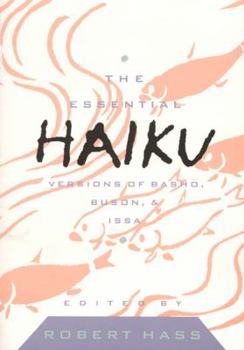The Essential Haiku: Versions of Bashō, Buson, and Issa
Select Format
Select Condition 
Book Overview
American readers have been fascinated, since their exposure to Japanese culture late in the nineteenth century, with the brief Japanese poem called the hokku or haiku . The seventeen-syllable form is rooted in a Japanese tradition of close observation of nature, of making poetry from subtle suggestion. Infused by its great practitioners with the spirit of Zen Buddhism, the haiku has served as an example of the power of direct observation to the first generation of American modernist poets like Ezra Pound and William Carlos Williams and also as an example of spontaneity and Zen alertness to the new poets of the 1950's. This definite collection brings together in fresh translations by an American poet the essential poems of the three greatest masters: Matsuo Basho in the seventeenth century; Yosa Buson in the eighteenth century; and Kobayashi Issa in the early nineteenth century. Robert Haas has written a lively and informed introduction, provided brief examples by each poet of their work in the halibun, or poetic prose form, and included informal notes to the poems. This is a useful and inspiring addition to The Essential Poets series.
Format:Paperback
Language:English
ISBN:0880013516
ISBN13:9780880013512
Release Date:August 1995
Publisher:Ecco Press
Length:352 Pages
Weight:0.75 lbs.
Dimensions:0.9" x 5.3" x 7.6"
Customer Reviews
5 ratings
Keep a Copy at Work and at Home
Published by Thriftbooks.com User , 21 years ago
I always find myself returning to this lovely collectionof haiku by Basho, Buson and Issa.The translations capture both the distinctive styles ofthe masters as well as the oft-mentioned "aha moment". I have only to turn a few pages to feel inspiration, motivation, exaltation and profound gratitude for thesebrief jewels. How they transcend time and place!Hass helpfully provides a wonderful introduction andnotes for these exquisitely crafted haiku. A recommendedbook for the novice and advanced reader/writer/loverof haiku.
Three Masters in the Haiku Tradition
Published by Thriftbooks.com User , 21 years ago
This book features versions of about one hundred poems by each of three masters in haiku tradition, Matsuo Basho (1644-1694), Yosa Buson (1716-1783), and Kobayashi Issa (1763-1827). The introduction tells us that according to Japanese literary criticism, these three men represent three types of the poet. Basho is seen as the ascetic and seeker, Buson the artist, and Issa the humanist. The differences in each poet's style can be seen at a glance. This book contains interesting short biographies of each of the men as well as some of their prose and notes on the poems. There are a few interesting black and white illustrations throughout the book including some by Yosa Buson himself. The introduction by Robert Hass is a superb introduction to haiku itself. These beautiful three line poems, located in Nature with their implied Buddhist reflection are each a meditation, a centering, and a crystalline moment of realization. Reading them has a way of bringing about calm and peace within the reader. The symbolism of the seasons and the Japanese habit of mind blend together in these poems to create an alchemy of reflection that is unsurpassed in literature. The exquisite skill of these three masters make their subject matter seem completely organic, without artifice. Each poem contains a unique "Ah!" experience because they pierce directly to the soul, activating the human capacity for seeing with a still mind and an observing heart. If you are new to haiku this is a wonderful compendium of the best of the genre. If you are already a lover of haiku this book is a delightfully compact, essential package, a real treasure you are sure to enjoy again and again.
The essential Haiku, by Robert Hass (editor)
Published by Thriftbooks.com User , 22 years ago
I bought this book four or maybe five years ago and it has never left me since. It's on my bedside table. Wherever and whenever I travel, this book accompanies me. Every time I read any of the haiku, I find something new - not as yet discovered - uplifting - in each.
A good book to add to any poetry collection
Published by Thriftbooks.com User , 23 years ago
This book is a collection of haiku by three great Japanese masters- Basho, Buson and Issa who all lived between the seventeenth and the nineteenth centuries. The book is divided into four sections, one on each master, followed by a section containing Basho's thoughts on haiku in general. Each of the first three sections starts with a brief but good introduction to the master followed by the translations of his haiku. Each section concludes with other pieces of writing (prose and haiku) by the poet. This helps to give a picture of the person behind the poem and some idea of the life and times that the poet lived in. Not being familiar with life in Japan from a few centuries ago, I found this very helpful in getting a better understanding of the context in which the poems are set.There are notes at the back which explain some of the nuances and anything significant one has to know about certain Haiku. It helps to keep this in mind when reading the haiku. The fourth section in the book "Basho on Poetry" is a joy to read, and captures the spirit of Haiku. Each sentence here is worth preserving! There is also a list of books for further reading which I found useful.Overall, this book is a good addition to the library, whether one is interested in writing Haiku or not.
Great translation
Published by Thriftbooks.com User , 25 years ago
I've read other translations of these poems; this one is my favorite. Some of them that seemed dull in previous translations are now among my favorite poems of all time. And I loved his description of Issa's life.





